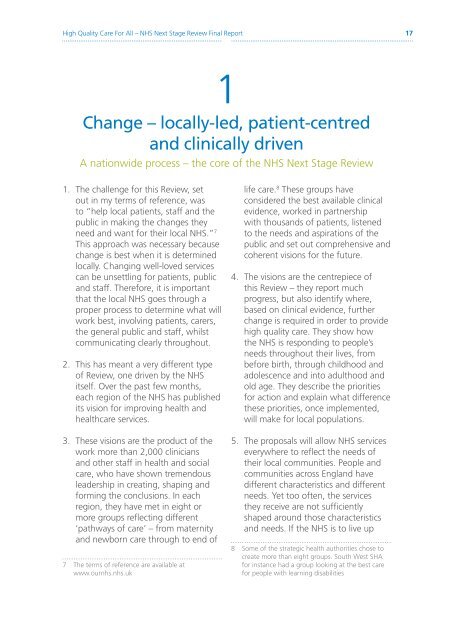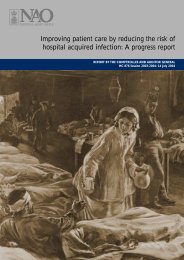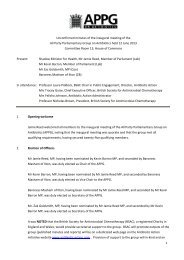High quality care for all NHS Next Stage Review - Antibiotic Action
High quality care for all NHS Next Stage Review - Antibiotic Action
High quality care for all NHS Next Stage Review - Antibiotic Action
You also want an ePaper? Increase the reach of your titles
YUMPU automatically turns print PDFs into web optimized ePapers that Google loves.
<strong>High</strong> Quality Care For All – <strong>NHS</strong> <strong>Next</strong> <strong>Stage</strong> <strong>Review</strong> Final Report171Change – loc<strong>all</strong>y-led, patient-centredand clinic<strong>all</strong>y drivenA nationwide process – the core of the <strong>NHS</strong> <strong>Next</strong> <strong>Stage</strong> <strong>Review</strong>1. The ch<strong>all</strong>enge <strong>for</strong> this <strong>Review</strong>, setout in my terms of reference, wasto “help local patients, staff and thepublic in making the changes theyneed and want <strong>for</strong> their local <strong>NHS</strong>.” 7This approach was necessary becausechange is best when it is determinedloc<strong>all</strong>y. Changing well-loved servicescan be unsettling <strong>for</strong> patients, publicand staff. There<strong>for</strong>e, it is importantthat the local <strong>NHS</strong> goes through aproper process to determine what willwork best, involving patients, <strong>care</strong>rs,the general public and staff, whilstcommunicating clearly throughout.2. This has meant a very different typeof <strong>Review</strong>, one driven by the <strong>NHS</strong>itself. Over the past few months,each region of the <strong>NHS</strong> has publishedits vision <strong>for</strong> improving health andhealth<strong>care</strong> services.3. These visions are the product of thework more than 2,000 cliniciansand other staff in health and social<strong>care</strong>, who have shown tremendousleadership in creating, shaping and<strong>for</strong>ming the conclusions. In eachregion, they have met in eight ormore groups reflecting different‘pathways of <strong>care</strong>’ – from maternityand newborn <strong>care</strong> through to end of7 The terms of reference are available atwww.ournhs.nhs.uklife <strong>care</strong>. 8 These groups haveconsidered the best available clinicalevidence, worked in partnershipwith thousands of patients, listenedto the needs and aspirations of thepublic and set out comprehensive andcoherent visions <strong>for</strong> the future.4. The visions are the centrepiece ofthis <strong>Review</strong> – they report muchprogress, but also identify where,based on clinical evidence, furtherchange is required in order to providehigh <strong>quality</strong> <strong>care</strong>. They show howthe <strong>NHS</strong> is responding to people’sneeds throughout their lives, frombe<strong>for</strong>e birth, through childhood andadolescence and into adulthood andold age. They describe the priorities<strong>for</strong> action and explain what differencethese priorities, once implemented,will make <strong>for</strong> local populations.5. The proposals will <strong>all</strong>ow <strong>NHS</strong> serviceseverywhere to reflect the needs oftheir local communities. People andcommunities across England havedifferent characteristics and differentneeds. Yet too often, the servicesthey receive are not sufficientlyshaped around those characteristicsand needs. If the <strong>NHS</strong> is to live up8 Some of the strategic health authorities chose tocreate more than eight groups. South West SHA<strong>for</strong> instance had a group looking at the best <strong>care</strong><strong>for</strong> people with learning disabilities





